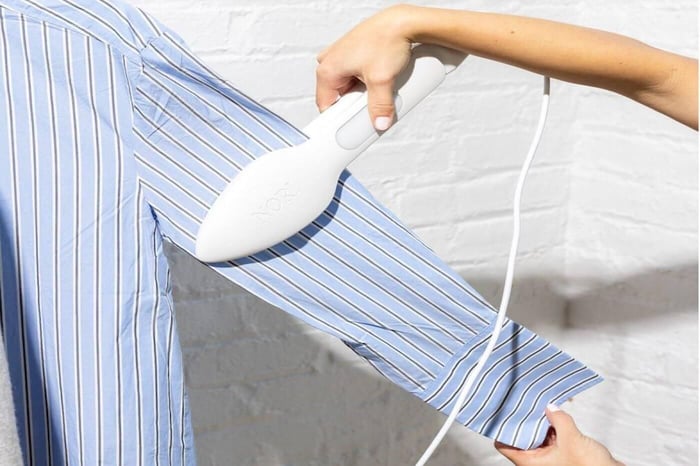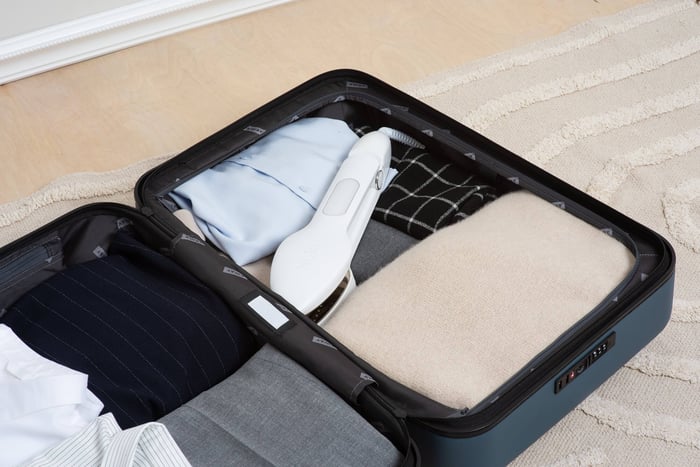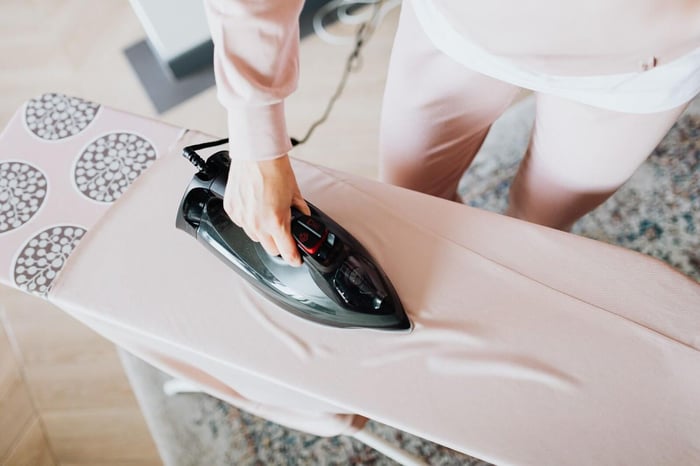
Whether it's just starting to look less than fresh or you're dealing with a burnt-on mess, there are plenty of tips about how to clean off an iron and keep it working as effectively as the first day you got it.
However, before we get started, I'd like to highlight The Nori Press - The Nori is more than an iron, it's a very easy use and clean next- generation wrinkle removing device. It harnesses the same technology as an iron or steamer, but in a new form factor that prioritizes efficiency. The device applies direct heat and pressure to remove unwanted wrinkles on both sides of your garment simultaneously. A garment is placed between the device’s two heated plates at which point the user should clamp firmly and drag slowly to press out wrinkles in its path. For exact instructions on how to press and/or steam, visit the How to Use Page. As for keeping the Nori clean, you can easily remove any starch, dirt, and other residues from your Nori with either a dry or damp all-cotton cloth. Similarly, with steam irons, you can clean the Nori vents with a cloth or Q-tip. Just like with any other appliance, it’s important to clean your clothing iron, yet so many people neglect to do so. Read on for our top twelve tips for how to clean a traditional iron without any fancy cleaning products!
generation wrinkle removing device. It harnesses the same technology as an iron or steamer, but in a new form factor that prioritizes efficiency. The device applies direct heat and pressure to remove unwanted wrinkles on both sides of your garment simultaneously. A garment is placed between the device’s two heated plates at which point the user should clamp firmly and drag slowly to press out wrinkles in its path. For exact instructions on how to press and/or steam, visit the How to Use Page. As for keeping the Nori clean, you can easily remove any starch, dirt, and other residues from your Nori with either a dry or damp all-cotton cloth. Similarly, with steam irons, you can clean the Nori vents with a cloth or Q-tip. Just like with any other appliance, it’s important to clean your clothing iron, yet so many people neglect to do so. Read on for our top twelve tips for how to clean a traditional iron without any fancy cleaning products!
- Remember that your iron is an electrical appliance and all of these remedies listed below should only be conducted while your iron is unplugged.
- Your iron should not be dipped in any of the liquids described so as not to ruin its electrical components.
Attention: Use discount code "SHOP10" at checkout to save 10% on The Nori Press!
1. Dissolve Tylenol Into a Hot Iron Soleplate
Before you grab the steel wool, try out this tip for how to clean an iron when it needs a little TLC. Dissolve two 300mg Tylenol, pour the mixture onto a towel and set your iron soleplate onto the towel (It can be any brand of acetaminaphin). Leave the soleplate on the soaked towel for several minutes. The dissolved pain reliever should release crusted-on debris from the soleplate. Use a damp cloth or paper towel to wipe off the soleplate, and repeat as necessary until the char is completely removed.
2. Create an Iron Cleaning Paste With Baking Soda
If the Tylenol trick doesn't work, it's time for a baking soda paste. Mix together 2 tablespoons of baking soda to 1 tablespoon of water to create an iron cleaning paste. Cover the soleplate with the mixture and let sit for 20 minutes. Use a damp cloth or paper towel to clean off the baking soda residue, then follow up with the Tylenol solution above. Use cotton swabs to clean the vents.
3. Re-Season Your Iron With Salt and Water
Discouraged by how often your iron requires cleaning? It might be time to re-season! This will work if your iron has a removable water reservoir. Remove the iron's water reservoir, fill it halfway with water, then add in 1 teaspoon of kosher salt. Bring the water to a boil and heat the iron for a minute or two. Do not use boiling water if the water reservoir is made of plastic The dissolved salt helps remove built-up residue on the iron and re-seasons the surface, which allows it to glide more easily across fabrics.
3. Use a Cotton Swab to Clean Out the Steam Holes
The holes where steam emerges from your iron is a typical place for gunk to build up, but it's easy enough to clean. Use a cotton swab or toothpick to remove anything blocking the steam hole. It may be helpful to turn the iron on and engage the steam function first. This will help to loosen some of that gunk.
4. Clean the Area Around the Steam Holes With a Dryer Sheet
Dryer sheets can work wonders on any spot where gunk frequently builds up. Rub the steam holes and the surrounding area with a dryer sheet to remove any residue. Be careful not to push down too hard, as you don't want to damage the surface of your iron! Turn the Iron to Low Heat and Scrub With Dryer Sheets Protect your hands with heat resistant gloves.
To clean the entire soleplate, you can rub the soleplate with dryer sheets while the iron is on its lowest setting. As soon as a dryer sheet gets too hot, toss it and reach for another. Repeat until the iron is clean.
5. Soak a Towel in Vinegar
If you're dealing with a particularly stubborn mess, try soaking the soleplate of your iron in hot vinegar for 10 to 15 minutes. Set the iron face down on a vinegar soaked towel. This method should remove any caked-on debris without damaging your iron's surface.
6. Make Magic With a Magic Eraser
Cut one in half, then slip the flat end under the water reservoir to clean out any grime that might be lingering there. For deeper cleaning, dampen a magic eraser and rub over the surface of your iron's soleplate. Magic erasers are gentle enough on your iron's finish, so they should still look brand-new after use. If your iron has a non stick surface this method is not an option. For any iron first try a small area of the soleplate to make certain that the eraser will not scratch your soleplate.
7. Iron Over a Newspaper and Salt
For a quick fix, iron over pieces of newspaper and 1/2 teaspoon salt and use the steam function. The salt dissolves into the steam, which helps lift away any gunk on the soleplate. You can also try this with a paper bag or white tissues— anything that you don't mind getting dirty! If you're using newspaper wipe the soleplate down with a clean cloth to remove any newspaper ink before you iron.
8.. Use Ice Cubes and a Plastic Knife to Remove Melted Plastic
If your iron comes into contact with something plastic, you'll likely end up with melted plastic stuck to the soleplate. First try setting your iron on a bed of ice cubes for about 10 minutes and then use a plastic knife to pick the plastic bits off. If this doesn't work then fill a cup halfway with ice cubes and add enough water to cover the ice. Add in a few drops of dish soap, then stir until you have an ice-soap mixture. Use a plastic knife to remove anything that remains on the soleplate. It's critical to get off any plastic before you use the iron again—otherwise, the plastic will end up melting into your clothes. Once again, place the soleplate over the ice cubes and do not immerse your iron in any liquid.
9. Remove Burnt Food With Non Abrasive Cleanser
If you accidentally get food onto the bottom of your hot iron, don't worry: You can still save it! Coat the bottom of the soleplate with a mixture of a non abrasive cleanser like Soft Scrub. Wipe away any softened food and wipe clean. Be careful to avoid the steam vents and to be certain turn the iron on when your done and engage the steam function. Wipe the vents with cotton swabs.
10. Use Rubbing Alcohol to Remove Grease or Oil
If your iron is covered in grease, reach for the rubbng alcohol! All you need is a few quick sprays to loosen up the gunk and make it easier to wipe away. For oil stains, dab a bit of rubbing alcohol onto the spot and let sit for 5 minutes before wiping clean.
11. Keep Steel Wool Handy To Remove Burn Marks From Your Iron
If you have stubborn burn marks on your iron, you can use a damp piece of steel wool to scrub it down without damaging the plates. Don't use this method if your iron has a non stick surface. Try the steel wool on a small portion of your soleplate to make certain that it will not be scratched.
12. Use A Hair Dryer For Hard-To-Reach Places On Your Iron
Another trick for how to clean an iron is to use a hairdryer on its cool setting and direct the air to the tight spots that you can't quite reach with a cloth or sponge. The directed air from the hairdryer will loosen anything that may be caught in the vents
FAQs About Cleaning Your Iron
- Is the bottom of a hot iron safe to touch, even after cleaning?
No. You can burn yourself with a hot iron so wait until it's cooled off if you're going to touch the sole plate. If you're cleaning a hot iron, it's always a good idea to wear heat resistant gloves for safety.
- Can I put my iron away while there are still wet patches on its surface?
Putting away your iron while there are still wet patches on the surface is fine. The heat of your dryer will help evaporate leftover water—so you're actually helping your iron to dry faster by putting it away right after cleaning. Always be certain to store your iron in the upright position and don't store a hot iron near flammables.
- What can I use if my iron's bottom has turned brown or black?
If the bottom of your iron has turned brown or black, it probably means you've let the water evaporate off your iron for far too long—which in turn has led to mineral deposits. If that's the case, there are a few ways that you can restore the color of your iron.
- For lighter stains, soak the offending area overnight in Coca-Cola and then scrub off the sticky mess with a toothbrush. To soak the bottom set it on a coca-cola soaked towel.
- For more stubborn stains, like rust spots, use hot water and vinegar and set the iron on a soaked towel for five minutes and then scrape it off with a plastic spatula.
- Rub metal polish like Brasso onto the surface of your iron to restore its shine. This is not suggested on a non stick soleplate and keep the Brasso away from the steam vents. Use cotton swabs to clean the vents.
- How do I remove rust from my iron?
If you want more protection against future rust formation, use metal polish like Brasso or SuperFinish to clean your iron—and then wipe down your iron with a damp cloth before putting it away. Always avoid the steam vents.
- What if my iron is badly discolored?
If your iron face plate has turned brown or black, there are probably mineral deposits caked onto the surface—and you're going to need a commercial cleaner like CLR to take care of those stains. You can once again set the iron facedown in a CLR soaked towel. Wipe away all of the CLR as it is a chemical that you should handle very carefully. Carefully wipe away all residue after cleaning. Always finish by turning the iron on and engaging the steam function to make certain that all of the CLR is gone.
- Can I use scouring powders to clean my iron?
Scouring powders are generally too harsh for delicate surfaces, so you should avoid using it on your iron. Likewise, abrasive sponges can scratch the surface of your iron. You can try a small area of the soleplate first.
- How often should I clean my iron?
If you want your iron to heat up faster and distribute heat more effectively, make sure that it's completely free of dust or other debris. For this reason, you'll want to clean your iron as often as you can to avoid future problems and any buildup.








